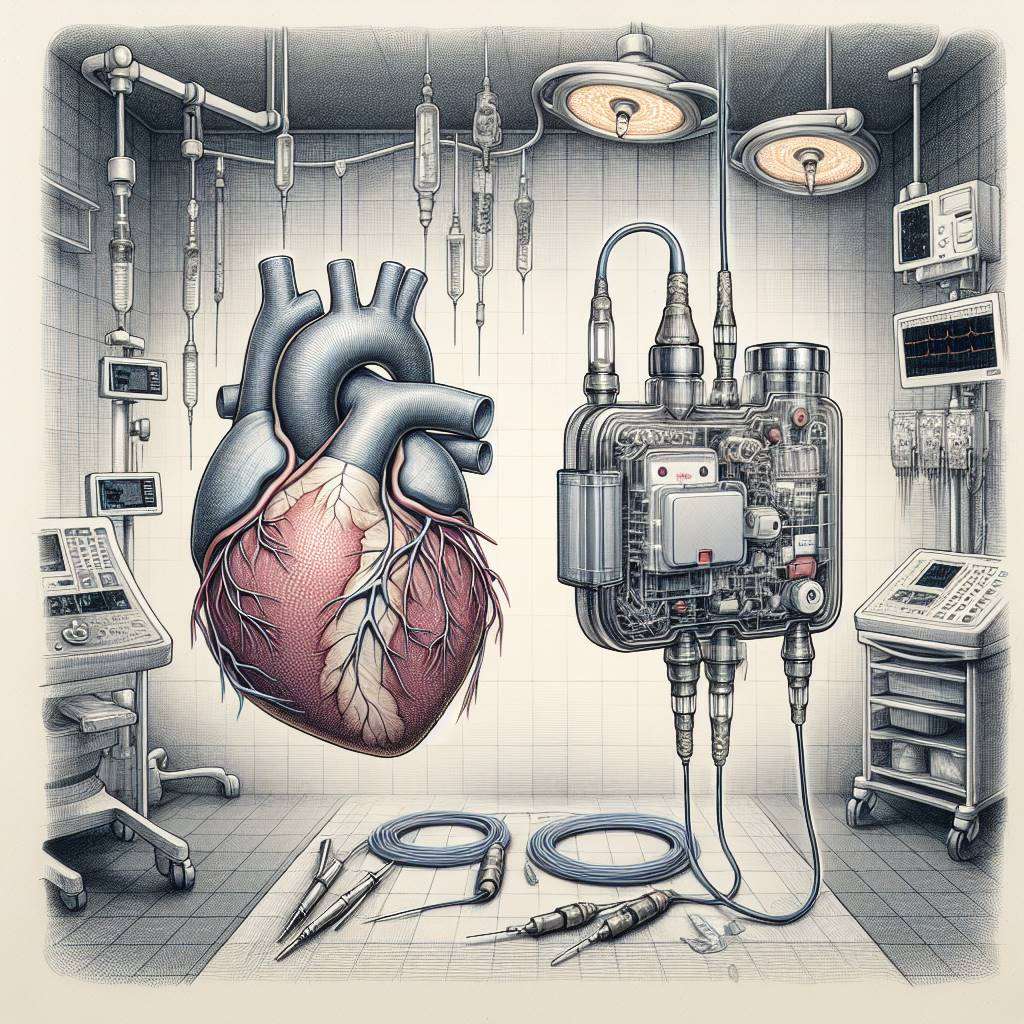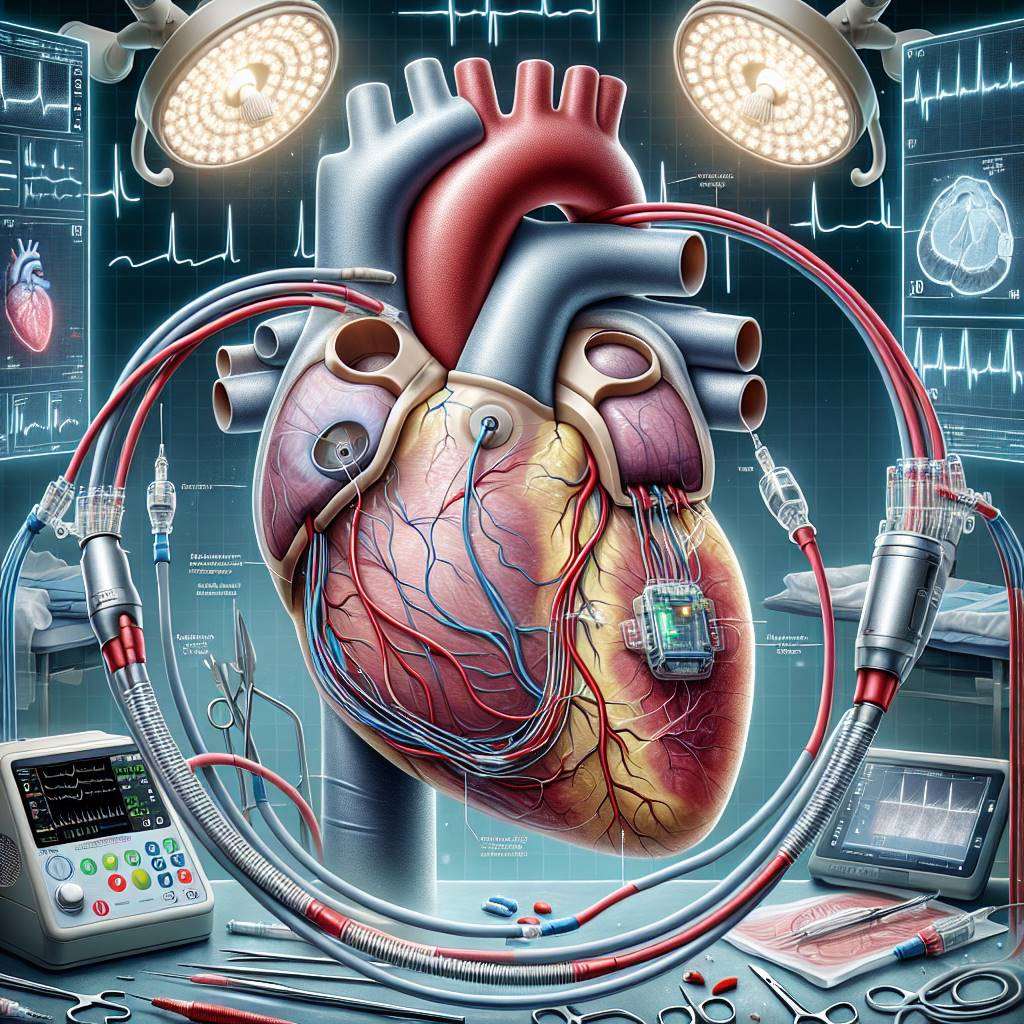When it comes to managing life-threatening heart conditions, choosing the right type of implantable cardioverter-defibrillator (AICD) is crucial. AICDs, including single-chamber and dual-chamber devices, help regulate abnormal heart rhythms and prevent sudden cardiac arrest. Understanding the differences between these devices can help patients and doctors make informed decisions about treatment options.
Both single-chamber AICDs and dual-chamber AICDs are designed to monitor and treat arrhythmias, but they differ in functionality and usage. Factors like the patient’s specific heart condition, lifestyle, and overall health play a significant role in determining the most suitable device. This article explores these differences to guide you in making the right choice.
What Are Single-Chamber and Dual-Chamber AICDs?
AICDs, or implantable cardioverter-defibrillators, are small devices implanted in the chest to monitor and correct abnormal heart rhythms. A single-chamber AICD has one lead, typically placed in the right ventricle, while a dual-chamber AICD has two leads, one in the right atrium and another in the right ventricle.
Single-chamber AICDs are often used for patients with simpler arrhythmias, such as ventricular tachycardia. In contrast, dual-chamber AICDs are more advanced and can manage both atrial and ventricular arrhythmias. These devices not only deliver shocks to restore normal rhythm but also provide pacing support when needed.
Choosing between these devices depends on the patient’s specific cardiac condition, such as atrial fibrillation or heart block. Understanding their functionality is the first step in determining the right option for your heart health.

Key Differences Between Single-Chamber and Dual-Chamber AICDs
The primary difference between single-chamber and dual-chamber AICDs lies in the number of leads and their placement. Single-chamber devices have one lead, which is placed in the right ventricle. Dual-chamber devices, on the other hand, have two leads: one in the right atrium and another in the right ventricle.
Here’s a comparison of their features:
| Feature |
Single-Chamber AICD |
Dual-Chamber AICD |
| Number of Leads |
1 |
2 |
| Conditions Treated |
Ventricular arrhythmias |
Atrial and ventricular arrhythmias |
| Complexity |
Simpler |
More advanced |
While single-chamber devices are less invasive and easier to implant, dual-chamber devices offer more comprehensive cardiac care for patients with complex arrhythmias. Discussing these differences with your doctor is essential to make the right choice.
How to Choose Between Single and Dual-Chamber AICDs
Choosing between a single-chamber AICD and a dual-chamber AICD depends on several factors, including your specific heart condition, overall health, and lifestyle. Patients with simple ventricular arrhythmias may benefit from a single-chamber device, while those with more complex conditions like atrial fibrillation or heart block may require a dual-chamber device.
Here are some considerations to guide your decision:
- Your doctor’s assessment of your arrhythmia type and severity.
- Whether you need pacing support in addition to defibrillation.
- Your age, activity level, and other health conditions.
It’s important to have an open discussion with your cardiologist to weigh the benefits and risks of each device. A thorough evaluation, including tests like an ECG or echocardiogram, can help determine the most suitable option for your needs.
Benefits of Single-Chamber AICDs for Heart Patients
Single-chamber AICDs are a simpler and less invasive option for patients with specific types of ventricular arrhythmias. These devices are designed to monitor and correct abnormal rhythms in the right ventricle, making them ideal for patients with straightforward cardiac issues.
One of the key advantages of single-chamber AICDs is their ease of implantation. With only one lead, the procedure is quicker and carries a lower risk of complications. Additionally, these devices are often more cost-effective, making them a practical choice for many patients.
While they may not offer the advanced features of dual-chamber devices, single-chamber AICDs are highly effective for patients who do not require pacing support in the atrium. They provide reliable protection against life-threatening arrhythmias, ensuring peace of mind for heart patients.
Advantages of Dual-Chamber AICDs for Cardiac Care
Dual-chamber AICDs offer advanced functionality for patients with complex cardiac conditions. By having two leads—one in the right atrium and another in the right ventricle—these devices can manage both atrial and ventricular arrhythmias, providing comprehensive heart rhythm management.
One of the major benefits of dual-chamber AICDs is their ability to provide pacing support in addition to defibrillation. This makes them ideal for patients with conditions like heart block or atrial fibrillation, where synchronized pacing is crucial for maintaining normal heart function.
Although dual-chamber devices are more complex and may require a longer implantation procedure, their advanced features make them a valuable option for patients with severe or multifaceted heart issues. By offering tailored treatment, these devices significantly improve quality of life and reduce the risk of sudden cardiac events.
Who Should Consider a Single-Chamber AICD?
A Single-Chamber Automated Implantable Cardioverter Defibrillator (AICD) is typically recommended for patients with specific heart rhythm disorders. This device is designed to monitor and correct abnormal heartbeats, particularly in the ventricles, which are the lower chambers of the heart. It is most suitable for individuals who do not require pacing in both the atrium and ventricle.
Patients with conditions like ventricular tachycardia or ventricular fibrillation may benefit from this device. It is also a good choice for those who have a structurally normal heart but are at risk of sudden cardiac arrest. However, it may not be ideal for patients with more complex heart rhythm issues that involve both chambers of the heart.

Is a Dual-Chamber AICD Right for You?
A Dual-Chamber AICD is designed to provide pacing and defibrillation support for both the atrium and ventricle. This device is often recommended for patients with more complex heart rhythm disorders, such as bradycardia or heart block, where the electrical signals between the upper and lower chambers of the heart are disrupted.
It is particularly beneficial for individuals who require synchronized pacing to maintain a normal heart rhythm. For example, patients with sick sinus syndrome or those who have undergone certain heart surgeries may find this device more suitable. However, the decision to implant a dual-chamber AICD depends on various factors, including the patient’s overall health and specific cardiac condition.
Cost Comparison: Single-Chamber vs. Dual-Chamber AICDs
The cost of an AICD can vary significantly depending on whether it is a single-chamber or dual-chamber device. In general, a single-chamber AICD is less expensive due to its simpler design and fewer components. On the other hand, a dual-chamber AICD is more costly because it offers advanced features and supports both chambers of the heart.
| Type of AICD |
Approximate Cost (INR) |
| Single-Chamber AICD |
5–7 lakhs |
| Dual-Chamber AICD |
8–12 lakhs |
It is important to consult with your cardiologist and insurance provider to understand the total cost, including the procedure, follow-up care, and device maintenance.
Risks and Complications of Single-Chamber AICDs
While a single-chamber AICD is effective in preventing sudden cardiac arrest, it is not without risks. Common complications include infection at the implantation site, bleeding, or bruising. In rare cases, the device may fail to deliver the necessary shock during a life-threatening arrhythmia.
Other potential issues include lead displacement, which can affect the device’s ability to monitor and correct heart rhythms accurately. Patients may also experience discomfort or allergic reactions to the materials used in the device. Regular follow-ups with your cardiologist are essential to monitor the device’s performance and address any complications promptly.
Potential Risks of Dual-Chamber AICD Implantation
The implantation of a dual-chamber AICD carries similar risks to that of a single-chamber device, but with additional considerations due to its complexity. Patients may experience lead-related complications, such as lead fracture or dislodgement, which can impact the device’s functionality.
Other risks include pneumothorax (collapsed lung) during the procedure, as well as a higher likelihood of infection due to the additional lead. Some patients may also experience inappropriate shocks, which can be distressing and require reprogramming of the device.
Despite these risks, the benefits of a dual-chamber AICD often outweigh the potential complications, especially for patients with advanced heart rhythm disorders. Discussing these risks with your healthcare provider is crucial for making an informed decision.
How Single-Chamber AICDs Work to Prevent Arrhythmias
Single-chamber AICDs (Automatic Implantable Cardioverter Defibrillators) are designed to monitor and regulate the heart's rhythm by focusing on a single chamber, typically the right ventricle. These devices are highly effective in treating ventricular tachycardia or ventricular fibrillation, which are life-threatening arrhythmias.
When the device detects an abnormal rhythm, it delivers a controlled electrical shock to restore the heart's normal rhythm. Single-chamber AICDs are often recommended for patients who do not require pacing in both the atrium and ventricle. They are simpler in design and may have fewer complications compared to dual-chamber devices.

Understanding the Functionality of Dual-Chamber AICDs
Dual-chamber AICDs are advanced devices that monitor and regulate the heart's rhythm in both the atrium and ventricle. These devices are particularly beneficial for patients with bradycardia or heart block, as they ensure proper coordination between the upper and lower chambers of the heart.
Unlike single-chamber AICDs, dual-chamber devices provide pacing support in both chambers, which can improve overall heart function. They are often recommended for patients with complex arrhythmias or those who require more precise rhythm management. However, they may involve a more complex implantation procedure and higher costs.
Recovery After Single-Chamber vs. Dual-Chamber AICD Surgery
Recovery after AICD implantation varies depending on the type of device and the patient's overall health. For single-chamber AICDs, the recovery period is generally shorter due to the simpler surgical procedure. Patients typically experience less discomfort and a quicker return to normal activities.
In contrast, dual-chamber AICD implantation may require a longer recovery time as it involves more intricate placement of leads in both the atrium and ventricle. Regardless of the device type, patients should follow their doctor's advice, avoid strenuous activities, and attend follow-up appointments to ensure proper healing.
- Avoid lifting heavy objects for at least 4-6 weeks.
- Monitor the surgical site for signs of infection.
- Report any unusual symptoms, such as dizziness or chest pain, to your doctor immediately.
Which AICD Type Is Best for Your Heart Condition?
The choice between a single-chamber and dual-chamber AICD depends on your specific heart condition and medical needs. Single-chamber AICDs are ideal for patients with isolated ventricular arrhythmias, while dual-chamber AICDs are better suited for those with conditions affecting both the atrium and ventricle.
Factors such as age, lifestyle, and the presence of other medical conditions also play a role in determining the best device. Your cardiologist will evaluate your heart's electrical activity, overall health, and risk factors to recommend the most suitable option. Always discuss the pros and cons of each device with your healthcare provider.
| Feature |
Single-Chamber AICD |
Dual-Chamber AICD |
| Target Area |
Right Ventricle |
Atrium and Ventricle |
| Complexity |
Simple |
Complex |
| Recovery Time |
Shorter |
Longer |
Expert Tips for Choosing the Right AICD Device
Choosing the right AICD device requires careful consideration of your medical history and lifestyle. Here are some expert tips to help you make an informed decision:
- Consult a cardiologist who specializes in arrhythmia management.
- Understand the benefits and limitations of both single-chamber and dual-chamber AICDs.
- Consider your long-term health goals and potential future needs.
- Ask about the risks, costs, and maintenance of each device.
- Ensure you have access to regular follow-up care and device monitoring.
Remember, the right device can significantly improve your quality of life and reduce the risk of life-threatening arrhythmias. Take the time to discuss all your options with your healthcare provider.
Best Aicd Implantation Doctors in India
Dr. Balbir Singh, a renowned cardiologist at Max Super Speciality Hospital, Delhi, specializes in electrophysiology with over 30 years of experience. Another expert is Dr. Praveen Chandra from Medanta - The Medicity, Gurugram, a leading interventional cardiologist with a DM in Cardiology and international recognition for his work in cardiac devices.
Learn more on best aicd implantation doctors in india
Best Aicd Implantation Hospitals in India
Fortis Escorts Heart Institute, Delhi, a NABH-accredited hospital, is known for its advanced electrophysiology labs and multidisciplinary cardiac care. Apollo Hospitals, Chennai, a JCI-accredited facility, offers cutting-edge technologies like robotic-assisted cardiac procedures and comprehensive international patient services.
Find more best aicd implantation hospitals in india
Aicd Implantation Cost in India
The cost of Single-Chamber AICD in India ranges from INR 4,00,000 to 6,00,000 (approximately USD 4,800 to 7,200), while Dual-Chamber AICD costs between INR 6,00,000 to 9,00,000 (around USD 7,200 to 10,800). Factors like the hospital's category, the doctor’s expertise, and the complexity of the procedure influence costs. India offers a significant cost advantage compared to Western countries, with medical insurance and financing options available.
Learn aicd implantation cost in india
Aicd Implantation Treatment in India
The implantation of AICDs in India involves a minimally invasive procedure under local anesthesia. Advanced technologies like 3D mapping and fluoroscopy ensure precision. Recovery typically takes 1-2 weeks, with most patients resuming normal activities soon after. Top hospitals in India adhere to global medical protocols and adopt innovations like leadless devices for enhanced outcomes.
Learn on Aicd Implantation Treatment in India
FAQs
What is the difference between a single-chamber and dual-chamber AICD?
A single-chamber AICD monitors and delivers therapy to one heart chamber, typically the right ventricle. A dual-chamber AICD monitors and treats both the right atrium and right ventricle, offering more comprehensive rhythm management.
Who is a candidate for a single-chamber AICD?
Patients with ventricular arrhythmias or those at risk of sudden cardiac arrest due to conditions like ischemic cardiomyopathy are typically candidates for single-chamber AICDs.
When is a dual-chamber AICD recommended?
A dual-chamber AICD is recommended for patients with bradycardia, heart block, or those needing pacing in both the atrium and ventricle for optimal heart function.
Is the implantation procedure painful?
The procedure is performed under local anesthesia and sedation, ensuring minimal discomfort. Post-procedure soreness at the incision site is common but manageable with medications.
What are the risks associated with AICD implantation?
Risks include infection, bleeding, or lead displacement. However, these complications are rare when performed by experienced specialists.
How long does an AICD last?
The battery life of an AICD typically ranges from 5 to 10 years, depending on usage. Regular follow-ups ensure timely replacement.
Can I travel with an AICD?
Yes, patients with an AICD can travel. However, it is advisable to carry your device card and inform airport security about the implant to avoid interference with metal detectors.
What lifestyle changes are necessary after AICD implantation?
Patients should avoid activities that may involve strong electromagnetic fields, follow a heart-healthy diet, and adhere to regular follow-ups with their cardiologist.
Is AICD implantation covered by insurance in India?
Yes, most health insurance policies in India cover AICD implantation. It is advisable to confirm coverage details with your insurance provider.
How soon can I return to normal activities after AICD implantation?
Most patients can resume light activities within a week and normal activities within 4-6 weeks, depending on their doctor’s advice.
Understanding AICD Settings and Genetic Factors in Cardiac Care
Automatic Implantable Cardioverter Defibrillators (AICDs) play a crucial role in managing life-threatening heart rhythms. The settings of these devices are meticulously determined by healthcare professionals, focusing on rate detection and shock thresholds. For an in-depth look at how doctors make these critical decisions, check out this informative article on how doctors decide AICD settings.
Moreover, genetic heart conditions can significantly influence the need for AICDs, especially when there is a family history of cardiac issues. Understanding the implications of genetics in cardiac health is vital for early intervention. To explore this topic further, read about genetic heart conditions and AICDs and how they can trigger the need for these life-saving devices.
By combining knowledge of AICD settings and genetic predispositions, patients and families can better navigate their cardiac health journey.